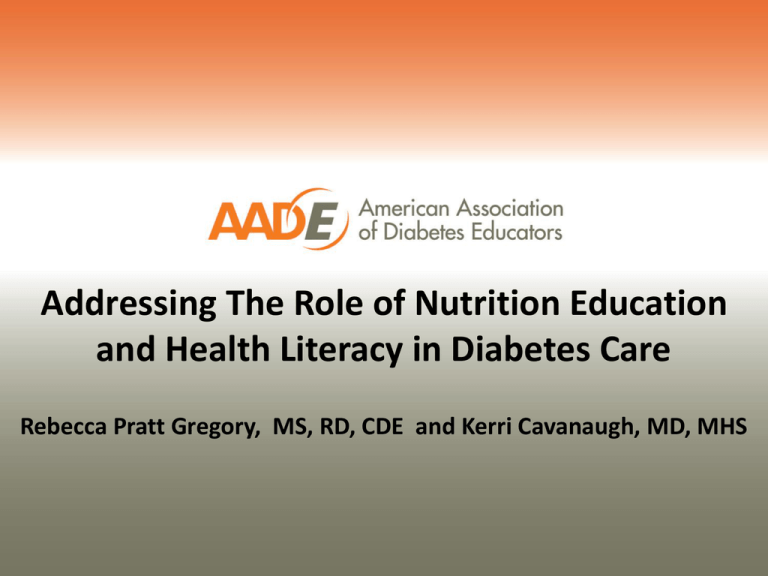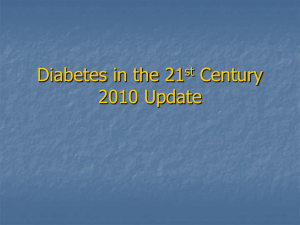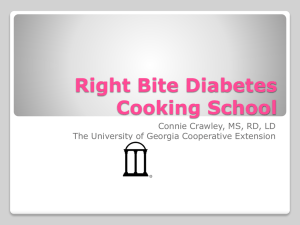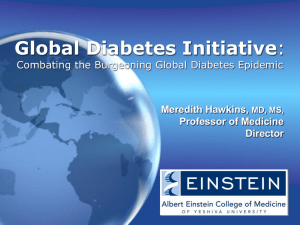
Addressing The Role of Nutrition Education
and Health Literacy in Diabetes Care
Rebecca Pratt Gregory, MS, RD, CDE and Kerri Cavanaugh, MD, MHS
Learning Objectives
• Review of impact of CDEs and medical nutrition therapy
(MNT) on diabetes outcomes
• Review health literacy & numeracy in diabetes self-care
• Describe design of new randomized controlled trial to:
– Examine the value of CDE in diabetes care
– Examine the role of different approaches to MNT
• Learn about study results, interpretation and
applications to clinical practice
2
Role of CDEs in Medical Nutrition Therapy in
Diabetes Care
• Diabetes self-management education (DSME) can improve
patient knowledge, behavior, and glycemic control
– Medical Nutrition Therapy is an essential part of DSME
• Addressing carbohydrates as a nutritional strategy is endorsed
by the ADA and the AADE
– Clinical trials have shown that MNT can improve A1C by 1-2%
– No studies have compared carbohydrate counting and plate method
• Facilitating positive behavior as well as transferring knowledge is
a priority, but little research in this area exists
3
Defining Health Literacy
Components of Literacy
Literacy
Cultural and
Conceptual
Knowledge
Listening
Speaking
Oral Literacy
Writing
Reading
Numeracy
Print Literacy
4
IOM, Health Literacy, 2004
Health literacy is associated with outcomes
Diabetes
Schillinger, JAMA, 2002
5
Components of Literacy
Literacy
Cultural and
Conceptual
Knowledge
Listening
Speaking
Oral Literacy
IOM, Health Literacy, 2004
Writing
Reading
Numeracy
Print Literacy
6
Definition of Numeracy
• The ability to use numbers in daily life.
[Rothman RL et al. AJPM 2006]
• Examples of numeracy skills
–
–
–
–
–
Calculations
Interpretation of graphs/labels
Time
Probability
Ability to deduce when and what math is
needed for a given situation.
7
Numeracy in diabetes care
•
•
•
•
•
•
Glucose monitoring
Carbohydrate counting
Sliding/correction scale Insulin
Calculating insulin:carbohydrate ratios
Insulin pump adjustment
Sick day management
8
Measurement of Diabetes Numeracy
Diabetes Numeracy Test (DNT)
Diabetes Care Domains
• Experts
Nutrition
Exercise
• 43-items
Blood Glucose Monitoring
Oral Medication Use
Insulin Use
• Diabetes and Numeracy Domains
• No time limit
Numeracy Domains
Addition
Subtraction
• Calculators could be used
Multiplication
Division
Fractions/Decimals
• Kuder-Richardson-20 coefficient=0.95
Multi-step mathematics
Time
Huizinga MM, et al. BMC Health Services Research 2008: 8;96
Numeration/Counting/Hierarchy
9
http://www.mc.vanderbilt.edu/diabetes/drtc/preventionandcontrol/tools.php
Diabetes Numeracy & A1C
Adjusted GLS regression model
Characteristic
A1c
95% Confidence Interval
DNT Score (per 10%)
-0.09
[-0.16 to -0.01]
0.03
Age
-0.17
[-0.24 to -0.10]
<0.001
Sex
0.09
[-0.22 to 0.40]
0.59
Race
0.17
[-0.17 to 0.52]
0.34
Years of Diabetes
0.04
[ 0.02 to 0.06]
<0.001
p-value
* Also adjusted for income, type of diabetes, and clinic
Cavanaugh K, et al. Ann Intern Med 2008; 148: 737-746
10
Diabetes
Literacy &
Numeracy
Education
Toolkit
(DLNET):
A RCT
Diabetes Literacy & Numeracy
Education Toolkit (DLNET)RCT
• Objective
– Evaluate a literacy and numeracy-focused diabetes self-management
education intervention on patient self-efficacy, satisfaction and
glycemic control
• Design
– Randomized controlled trial
• Setting
– Enhanced diabetes education programs
• Intervention
12
DLNET Intervention
Control
(Enhanced Care)
Intervention
(Enhanced Care Plus
Literacy/Numeracy)
Nurse practitioner/CDE visits (1-3) Nurse practitioner/CDE visits (1-3)
Dietitian/CDE visits (1-3)
Dietitian/CDE visits (1-3)
Usual diabetes patient
education materials
Diabetes Literacy & Numeracy
Education Toolkit (DLNET)
Clear health communication
training
Usual care from primary care or
endocrine physician
Usual care from primary care or
endocrine physician
13
DLNET Toolkit
Goals
• Facilitate diabetes education and self-management
• Type 1 or Type 2 diabetes mellitus
• Oral medications or insulin
• Individual modules to customize for each patient
• Blood Glucose Monitoring
• Exercise planning
• Foot care
• Nutritional management
• Carbohydrates
• Medications
• Logbooks/worksheets
Available at:
www.mc.vanderbilt.edu/diabetes/drtc/preventionandcontrol/tools.php
Wolff K et al. The Diab Educ 2009
14
DLNET Toolkit
• Text at 5th grade reading level
• Color coding
• Pictures for key concepts
• Step-by-step instructions
•
Simplified medication instructions
• Practice skills worksheets
15
Wolff K et al. The Diab Educ 2009
DLNET Study Results
A1c
3-months
Adjusted
p-value
[Intervention vs.
Control]*
6-months
Adjusted pvalue
[Intervention
vs. Control]*
Intervention
-1.63 [ -2.03 , -1.23]
0.03
-1.11 [ -1.54,-0.65]
0.437
Control
-0.97 [-1.37 , -0.53 ]
-1.17 [-1.61,-0.71]
Mean [95% bootstrap Confidence Interval]
*Adjusting for age, gender, race, type of diabetes, income level, site of intervention and baseline DNT score and Hba1c levels
Cavanaugh KL et al. Diabetes Care 2009
16
Diabetes
Nutrition
Education
Study (DINES):
A Randomized
Controlled Trial
Diabetes Nutrition Study (DINES)
• Objectives
– To perform a randomized controlled trial to
determine the efficacy of RD CDE medical
nutrition therapy compared to usual care in
the treatment of type 2 diabetes mellitus
– To evaluate differences in glycemic control
by MNT strategy (carbohydrate counting vs.
modified plate method)
18
Diabetes Nutrition Study (DINES)
Methods
• Design: Randomized controlled trial
• Setting:
– Vanderbilt University Medical Center
– Regional primary care clinics (middle TN)
• Participants:
Inclusion criteria
Adults, Type 2 DM
A1c > 7%
No MNT past year
English-speaking
Exclusion criteria
Using flexible insulin
Poor vision
Cognitive impairment
Terminal illness
19
Diabetes Nutrition Study (DINES)
• Nutrition Education Intervention
20
Control Group
• 2-3 patient encounters
• Covered general nonnutrition topics:
–
–
–
–
–
–
Foot care
Fall prevention
Immunizations
Osteporosis
Diabetic Retinopathy
Oral care
21
Diabetes Nutrition Study (DINES)
• Nutrition Education Intervention materials
22
23
Modified Plate Method
• Number of carb
portions defined
• Based on glucose
response to meals
• Higher carb foods
listed with amounts
per carb serving
24
25
Methods: Measures
• Primary outcome
– Hemoglobin A1C (%) at 3- and 6-Months
• Secondary outcomes
–
–
–
Perceived Self-efficacy of Diabetes Self-management Scale (PDSMS)
Summary of Diabetes Self-Care Activities Measure (SDSCA)
Diabetes Treatment Satisfaction Questionnaire (DTSQ)
• Potential Confounding variables
– Patient characteristics/demographics
• Diabetes-related numeracy (DNT)
• Health literacy (Rapid Estimate of Adult Literacy in Medicine-REALM)
• Statistical Analyses
– Wilcoxon rank-sum or Kruskal-Wallis test, as appropriate
– Adjusted analyses: Linear regression modeling with Huber-White
robust covariance matrix estimate for repeated measurements
– Pre-specified subgroup analysis: Baseline A1C 7-10%
26
Diabetes Nutrition Study (DINES)
Referred
293
Refused: 80
Excluded/Not eligible: 63
Enrolled: 150
Carb
Counting: 50
Withdrew/Dropped: 8
6M: 42 (84%)
Plate Method: 50
Control: 50
Withdrew/Dropped: 5
6M: 45 (90%)
Withdrew/Dropped: 4
6M: 46 (92%)
27
Diabetes Nutrition Study (DINES)
Participant Characteristics
Carb Counting
Plate Method
Control
n=50
n=50
n=50
Age (yrs)
54 (47, 68)
55 (45, 60)
57 (48, 62)
% Male
38%
54%
48%
% White
58%
73%
66%
14 (13, 16)
14 (12, 16)
14 (13, 16)
% Income <$20k/yr
22%
26%
22%
% Smoke
14%
22%
10%
8 (4, 10)
7 (3, 10)
8 (3, 13)
% Insulin
28%
42%
34%
% Prior DM education
52%
54%
68%
34 (30, 37)
34 (30, 39)
34 (30, 39)
% Literacy <9th grade
8%
14%
10%
DNT Score (0-100%)
73 (40, 93)
67 (40, 85)
28
67 (47,
80)
Characteristic
Education (yrs)
Diabetes Duration (yrs)
Body mass index (kg/m2)
Median (Interquartile Range)
Diabetes Nutrition Study (DINES)
Participant Characteristics Baseline
Characteristic
Carb Counting
Plate Method
Control
n=50
n=50
n=50
Hemoglobin A1C (%)
8.4 (7.6, 9.7)
8.3 (7.5, 10.4)
8.0 (7.5, 9.7)
Weight (lbs)
218 (190, 252)
224 (189, 259)
216 (180, 243)
Self-efficacy: PDSMS [8-40]
24 (18, 29)
24 (21, 27)
24 (21, 29)
General Diet
3.5 (1.5, 5)
4.0 (2.5, 5)
3.5 (2.5, 5.5)
Specific Diet
3.5 (2, 4.5)
3.0 (2, 4.4)
3.2 (2, 4.5)
Exercise
1.5 (0.1, 3.4)
2.5 (0.5, 3.9)
2.0 (0.5, 3.9)
Blood glucose monitoring
3.5 (1.1, 5.9)
6.0 (2.1, 7)
5.0 (0.6, 7)
Foot care
3.5 (1.5, 5.9)
3.5 (1.1, 5.9)
3.5 (2, 6.5)
Medications
7.0 (5.2, 7)
7.0 (7, 7)
7.0 (7, 7)
24 (17, 30)
22 (17, 29)
26 (19, 31)
29
Self-management: SDSCA [0-7]
Satisfaction: DTSQ [0-48]
Median (Interquartile Range)
Diabetes Nutrition Study (DINES)
A1C at 3-months & 6-months by study group
Variable
Group
Baseline
Baseline to
3 months
A1C (%)
Carb
Count
8.4 (7.6, 9.7)
7.3 (6.9, 8.5)
Plate
8.3 (7.5, 10.4)
Baseline to
6 months
n=37
7.8 (6.9, 9.7)
n=41
n=50
∆ A1C
-0.70 (-1.2, -0.1)
-0.30 (-1, 0.2)
7.5 (6.9, 8.4)
7.5 (6.9, 8.4)
n=42
n=43
n=50
-0.60 (-1.5, -0.3)
Control 8.0 (7.5, 9.7)
7.3 (6.9, 7.9)
-0.50 (-1.2, 0.05)
n=41
7.8 (7, 9.2)
n=42
n=50
-0.60 (-1.4, 0.0)
-0.30 (-0.80, 0.4)
Median (Interquartile Range)
30
Diabetes Nutrition Study (DINES)
A1C at 3-months & 6-months by study group
8.6
8.4
A1C (%)
8.2
8
Carb
7.8
Plate
7.6
Control
7.4
7.2
7
Baseline
3-Month
6-Month
31
Diabetes Nutrition Study (DINES)
Adjusted A1C
Carb Counting
Mean
ΔA1C (%)
6-Months
95% Confidence Interval
p-value
-4.9
[-11.9 – 1.7]
0.220
-6.6
[-13.3 – 0.1]
0.051
-5.9
[-12.5 – 0.4]
0.065
vs. Control
Plate
vs. Control
CDE
vs. Control
•Adjusted for age, gender, race, income, years of diabetes, baseline A1C, and time interval
32
Diabetes Nutrition Study (DINES)
Adjusted A1C: Subgroup Analysis
Participants with baseline A1C > 7.0% & <10.0%
Carb Counting
Mean
ΔA1C (%)
6-Month
95% Confidence Interval
p-value
-9.3
[-17.9 - -1.8]
0.005
-8.2
[-16.6 - -0.9]
0.005
-8.6
[-17.3 - -1.6]
0.002
vs. Control
Plate
vs. Control
CDE
vs. Control
•Adjusted for age, gender, race, income, years of diabetes, baseline A1C, and time interval
33
Diabetes Nutrition Study (DINES)
Secondary outcomes at 3- & 6-months
Variable
Treatment
Arm
Baseline
Baseline to
3 months
Baseline to
6 months
Weight, lbs
Carb
218 (189, 253)
-1 (-5.3, 0.3)
-1.8 (-6.5, 1)
Plate
224 (189, 259)
-1 (-3.5, 0)
-1.0 (-10, 5)
Control
216 (180, 243)
0 (-2, 2.6)
0 (-4, 5.8)
Carb
24 (17, 30)
3 (0.3, 8.5)
4 (-1, 9)
Plate
22.5 (17, 29)
7 (0.5, 11)
7 (1, 13)
Control
26 (19, 31)
2 (-1, 5)
3 (-2, 9)
Carb
23.5 (18, 29)
2 (0, 9)
2 (0, 9)
Plate
24 (21, 27)
4 (-1, 10)
5 (-2, 8)
Control
24 (21, 29)
3 (-2, 7)
2.5 (0, 8)
Treatment
Satisfaction
(range 6-36)
Self-Efficacy
(range 8-40)
Median (Interquartile Range)
34
•Adjusted for age, gender, race, income, years of diabetes, baseline A1C, and time interval
Diabetes Nutrition Study (DINES)
Secondary outcomes at 3- & 6-months
Variable
Treatment
Arm
Baseline
Baseline to
3 months
Baseline to
6 months
Weight, lbs
CDE
220 (189, 258)
-1 (-5, 0)
-1.7 (-10, 4.2)
Control
216 (180, 243)
0 (-2, 2.6)
0 (-4, 5.8)
CDE
23 (17, 29)
6 (0, 11)
6 (0, 12)
(range 6-36)
Control
26 (19, 31)
2 (-1, 5)
3 (-2, 9)
Self-Efficacy
CDE
24 (20, 28)
3 (-1, 9)
4 (-1, 8.8)
Control
24 (21, 29)
3 (-2, 7)
2.5 (0, 8)
Treatment
Satisfaction
(range 8-40)
Median (Interquartile Range)
•Adjusted for age, gender, race, income, years of diabetes, baseline A1C, and time interval
35
Diabetes Nutrition Study (DINES)
Secondary outcomes change: Subgroup Analysis
Participants with baseline A1C > 7.0% & <10.0%
Variable
Treatment
Arm
Baseline
Baseline to
3 months
Baseline to
6 months
Weight, lbs
CDE
216 (187, 249)
-1 (-5, 0)
-2 (-10, 2.8)
Control
200 (180, 234)
0 (-2, 4.5)
0 (-4, 3.0)
CDE
23 (17, 29)
5 (-0.5, 11)
7 (0, 12)
(range 6-36)
Control
26 (19, 31)
0 (-2, 4)
2 (-2, 7)
Self-Efficacy
CDE
24 (20, 28)
3 (-1, 8)
4 (0, 8)
Control
24 (21, 29)
4 (-2, 8)
2 (0, 8)
Treatment
Satisfaction
(range 8-40)
Median (Interquartile Range)
•Adjusted for age, gender, race, income, years of diabetes, baseline A1C, and time interval
36
Summary
• At 3- and 6-months the A1C of intervention and control groups
significantly improved from baseline
• At 6-months there was a trend for greater improvement in A1C for
both intervention groups compared to control
• In subgroups analyses for participants with baseline A1C 7-10%,
both plate and carb counting resulted in significant improvement
in glycemic control
• CDE delivered MNT resulted in greater reduction in weight and
improvement in patient satisfaction scores compared to control
37
Limitations
• Minimal prevalence of low health literacy subjects
limited ability to evaluate literacy intervention effect on
A1C
• Highly motivated group as shown by significant
improvement in glycemic control in control arm
• Pts self-initiated changes within meal planning group
– Some went from plate to carb gram counting;
– Some in carb group didn’t count carbs
• Losses to follow-up/ missing data
• Short duration of follow-up limits examination of
persistence of MNT skills in intervention arms
38
Lessons Learned:
Applications to clinical practice
• Diabetes MNT must be tailored
to the individual:
- no pre-determined meal planning
strategy
- no pre-set calorie/carb levels
- nutrition intervention needs to be based
on assessment
39
Lessons Learned
• The tool is only as good as the user
• Carb portioning regardless of
method is beneficial
40
Lessons Learned
• Low literacy and picture based materials well-received by all
DLNET
ACP Living with Diabetes Guide
41
Conclusions
• CDE delivered MNT is an important
component of comprehensive diabetes
care and all methods improve glycemic
control
• Tailored education may benefit patients,
but larger studies are needed
42
Acknowledgements
Vanderbilt Program on Effective
Health Communication
•
•
•
•
•
•
•
•
•
•
•
•
•
Russell Rothman, MD, MPP
Kerri Cavanaugh MD MPH
Dianne Davis RD CDE
Becky Gregory RD CDE
Kathleen Wolff,
Ken Wallston PhD
Duff Green BA MDiv
Tom Elasy MD MPH
Robert Dittus MD MPH
Ayumi Shintani PhD
Svetlana Eden, MS
Matt Kennon
Shari Barto
• Funding
– American
Association of
Diabetes Educators
– NIH/NIDDK
• K23DK080952
(Cavanaugh)
• K23DK065294
(Rothman)
• 5P60DK020593
(VUMC DRTC)
• Extra slides
Health literacy is associated with outcomes
Diabetes intervention study
• Design: RCT
• Setting: Primary Care
• Intervention
►
►
►
►
►
Diabetes Education
Evidence-based medication
algorithms
Database to track and manage
patient outcomes
Diabetes Care Coordinator
Addressed health literacy
–
–
–
–
Individualized verbal education
Materials
Clear communication
“Teach back” techniques
45
Factors for health communication
MNT
46
Baker DW JGIM 2006; 21: 878-83
Health literacy & outcomes
Health Outcomes/ Health Services
Behaviors
- BMI
- General Health Status
- Hospitalization
- Mortality
- Emergency department care
- Depression
- Diabetes Control
- HIV Control
- Prostate Cancer Stage
- Mammography
- Pap smear, STD screening
- Immunizations
- Cost
- Breastfeeding
- Medication adherence
- Smoking, substance abuse
Knowledge
- Food label & portion size estimation
- Birth control
- Emergency department instructions
- Asthma
- Hypertension
- Diabetes
47
DNT Example Items
If you ate the entire bag of chips,
how many total grams of
carbohydrate would you eat?
Nutrition Facts
Serving Size 1oz. (28g/About 10 chips)
Servings Per Container 3.5
Your target blood sugar is
between 60 and 120. Circle the
values below that are in the
target range (circle all that apply):
55
145
118
Amount Per Serving
Calories 140
Calories from Fat 60
% Daily Value*
Total Fat 6g
10%
Saturated Fat 0.5g
4%
Cholesterol 0mg
0%
Sodium 150 mg
7%
Total Carbohydrate 18g
6%
Correct Response: 63 g
Correct: 44%
Correct Response: Circle 118 only
Percent Correct: 74%
48
Diabetes Nutrition Study (DINES)
Secondary outcomes: Subgroup Analysis
Participants with baseline A1C > 7.0% & <10.0%
Variable
Treatment
Arm
Baseline
Baseline to
3 months
Baseline to
6 months
Weight, lbs
Carb
218 (188, 252)
-2 (-6.2, 0)
-2.5 (-10, 1)
Plate
212 (181, 238)
-0.7 (-3.5, 0)
-1.5 (-10, 4.2)
Control
200 (180, 234)
0 (-2, 4.5)
0 (-4, 3.0)
Carb
24 (18, 30)
3 (0, 8.5)
4 (-1, 10)
Plate
22 (18, 28)
6 (-1, 11)
7.5 (1, 13.5)
Control
26 (19, 31)
0 (-2, 4)
2 (-2, 7)
Carb
24 (20, 29)
2 (-0.8, 7)
2 (0, 8)
Plate
24 (21, 26)
4 (-1, 9)
5 (-0.3, 8.5)
Control
23 (20, 29)
4 (-2, 8)
2 (0, 8)
Treatment
Satisfaction
(range 6-36)
Self-Efficacy
(range 8-40)
Median (Interquartile Range)
•Adjusted for age, gender, race, income, years of diabetes, baseline A1C, and time interval








